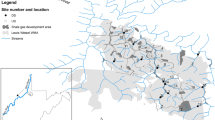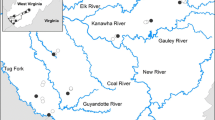Abstract
Unconventional natural gas development and hydraulic fracturing practices (fracking) are increasing worldwide due to global energy demands. Research has only recently begun to assess fracking impacts to surrounding environments, and very little research is aimed at determining effects on aquatic biodiversity and contaminant biomagnification. Twenty-seven remotely-located streams in Pennsylvania’s Marcellus Shale basin were sampled during June and July of 2012 and 2013. At each stream, stream physiochemical properties, trophic biodiversity, and structure and mercury levels were assessed. We used δ15N, δ13C, and methyl mercury to determine whether changes in methyl mercury biomagnification were related to the fracking occurring within the streams’ watersheds. While we observed no difference in rates of biomagnificaion related to within-watershed fracking activities, we did observe elevated methyl mercury concentrations that were influenced by decreased stream pH, elevated dissolved stream water Hg values, decreased macroinvertebrate Index for Biotic Integrity scores, and lower Ephemeroptera, Plecoptera, and Trichoptera macroinvertebrate richness at stream sites where fracking had occurred within their watershed. We documented the loss of scrapers from streams with the highest well densities, and no fish or no fish diversity at streams with documented frackwater fluid spills. Our results suggest fracking has the potential to alter aquatic biodiversity and methyl mercury concentrations at the base of food webs.




Similar content being viewed by others
References
Baptista DF, Buss DF, Egler M, Giovanelli A, Silveira MP, Nessimian JL (2007) A multimetric index based on benthic macroinvertebrates for evaluation of Atlantic Forest streams at Rio de Janeiro State, Brazil. Hydrobiologia 575:83–94
Barbour, MT, Gerritsen, J, Snyder, BD, Stribling, JB, Macroinvertebrates, B (1998) Rapid bioassessment protocols for use in streams and wadeable rivers: periphyton, benthic macroinvertebrates and fish, Second Edition. US Environmental Protection Agency Office of Water Washington DC, USEPA. 2nd edn. p 339.
Chalfant B (2012) Benthic macroinvertebrate index of biotic integrity from wadeable freestone rif-fle-run streams in Pennsylvania. Pennsylvania Department of Environmental Protection, Division of Water Quality Standards, Harrisburg, PA
Chasar LC, Scudder BC, Stewart AR, Bell AH, Aiken GR (2009) Mercury cycling in stream ecosystems. 3. Trophic dynamics and methylmercury bioaccumulation. Environl Sci Technol 43:2733–2739
Chételat J, Amyot M, Garcia E (2011) Habitat-specific bioaccumulation of methylmercury in invertebrates of small mid-latitude lakes in North America. Environ Pollut 159:10–17
Dittman J, Shanley J, Driscoll C, Aiken G, Chalmers A, Towse J, Selvendiran P (2010) Mercury dynamics in relation to dissolved organic carbon concentration and quality during high flow events in three northeastern U.S. streams. Water Resour Res 46(7):W07522. doi:10.1029/2009WR008351
Drohan PJ, Brittingham M, Bishop J, Yoder K (2012) Early trends in landcover change and forest fragmentation due to shale-gas development in Pennsylvania: a potential outcome for the northcentral Appalachians. Environ Manage 49:1061–1075
Entrekin S, Evans-White M, Johnson B, Hagenbuch E (2011) Rapid expansion of natural gas development poses a threat to surface waters. Front Ecol Environ 9:503–511
Ferrar KJ, Kriesky J, Christen CL, Marshall LP, Malone SL, Sharma RK, Michanowicz DR, Goldstein BD (2013) Assessment and longitudinal analysis of health impacts and stressors perceived to result from unconventional shale gas development in the Marcellus shale region. Inter J Occupa Environ Health 19:104–112
Garvie, KH, Shaw, K (2015) Shale gas development and community response: perspectives from treaty 8 territory, British Columbia. Local Env 21(8):1–20
Gesch, DB (2007) The national elevation dataset. In: Maune, D. (ed)Digital elevation model technologies and applications: The DEM users manual, 1st edn. American Society for Photogrammetry and Remote Sensing, Bethesda, MD, pp 99–118
Grant CJ, Weimer AB, Marks NK, Perow ES, Oster JM, Brubaker KM, Trexler RV, Solomon CM, Lamendella R (2015) Marcellus and mercury: assessing potential impacts of unconventional natural gas extraction on aquatic ecosystems in northwestern Pennsylvania. J Environ Sci Health, Part A 50:482–500
Jardine TD, Kidd KA, Rasmussen JB (2012) Aquatic and terrestrial organic matter in the diet of stream consumers: implications for mercury bioaccumulation. Ecol Appl 22:843–855
Jardine TD, Kidd KA, O’ Driscoll N (2013) Food web analysis reveals effects of pH on mercury bioaccumulation at multiple trophic levels in streams. Aquat toxicol (Amsterdam, The Netherlands) 132–133:46–52
Kelly CA, Rudd JWM, Holoka MH (2003) Effect of pH on mercury uptake by an aquatic bacterium: implications for Hg cycling. Environ Sci Technol 37:2941–2946
Kharaka YK, Thordsen JJ, Conaway CH, Thomas RB (2013) The energy-water nexus: potential groundwater-quality degradation associated with production of shale gas. Procedia Earth Planetary Sci 7:417–422
Levis E (2011) Texas Company Pays $93,710 settlement for polluting Clearfield County Creek. Pennsylvania Fish and Boat Commision. https://hero.epa.gov/hero/index.cfm/reference/details/reference_id/2447894. Accessed May 2016
Liu G, Cai Y, O’Driscoll N, Feng X, Jiang G (2011) Overview of Mercury in the Environment. Environmental Chemistry and Toxicology of Mercury. John Wiley & Sons Inc, Hoboken, NJ, pp 445–471
Llewellyn GT, Dorman F, Westland JL, Yoxtheimer D, Grieve P, Sowers T, Humston-Fulmer E, Brantley SL (2015a) Evaluating a groundwater supply contamination incident attributed to Marcellus Shale gas development. Proceedings of the National Academy of Sciences 112:6325–6330
Lutz, MA, Brigham, ME, Marvin-Di Pasquale, M (2008) Procedures for Collecting and Processing Streambed Sediment and Pore Water for Analysis of Mercury as Part of the National Water-Quality Assessment Program. US Geological Survey, Reston, VA.
Merritt, RW, Cummins, KW, Berg, MB (2008) An introduction to the aquatic insects of North America, 4th Edn. Kendall Hunt Publisher, Dubuque, IA
Mierzykowski SE, P Ruksznis, D McCaw, J Czapiga (2008) Environmental contaminants in brook trout (Salvelinus fontinalis) from Cove Brook and two tributaries of the Sheepscot River. USFWS. Spec. Proj. Rep. FY07-MEFO-5-EC. Maine Field Office. Old Town, ME. 41 pp.
New York State Department of Environmental Conservation. (2011) Supplemental Generic Environmental Impact Statement Regulatory Program Well Permit Issuance for Horizontal Drilling And High-Volume Hydraulic Fracturing to Develop the Marcellus Shale and Other Low-Permeability Gas Reservoirs. New York State Department of Environmental Conservation, Albany, NY.
PADEP (2012a) Pennsylvania Department of Environmental Protection (PA DEP). Permits Issued Detail Report, http://www.depreportingservices.state.pa.us/ReportServer/Pages/ReportViewer.aspx?/Oil_Gas/Permits_Issued_Detail
PADEP (2012b) Pennsylvania Department of Environmental Protection (PA DEP) SPUD Data Report, http://www.depreportingservices.state.pa.us/ReportServer/Pages/ReportViewer.aspx?/Oil_Gas/Spud_External_Data
PADEP (2013) 2013 Oil and Gas Annual Report, http://www.elibrary.dep.state.pa.us/dsweb/Get/Document-100389/2013%20Oil%20and%20Gas%20Annual%20Report%20with%20cover.pdf
PAMAP (2016) PAMAP program land cover for Pennsylvania. Pennsylvania geospatial data clearinghouse; University Park, PA, 2005. Available at http://www.pasda.psu.edu/uci/FullMetadataDisplay.aspx?file=palanduse05utm18nad83.xml. Accessed Mar 2016
PASDA (2016) Networked streams of Pennsylvania. Pennsylvania Geospatial Data Clearinghouse, 1998. http://www.pasda.psu.edu/uci/FullMetadataDisplay.aspx?file=netstreams1998.xml. Accessed Mar 2016
Peduzzia P, Harding R (2013) Gas fracking: can we safely squeeze the rocks?. Environ Dev 6:86–99
Perkins MJ, McDonald RA, van Veen FJF, Kelly SD, Rees G, Bearhop S (2014) Application of nitrogen and carbon stable isotopes (δ(15)N and δ(13)C) to quantify food chain length and trophic structure. PloS one 9:e93281
R Development Core Team, R (2014) R: A language and environment for statistical computing. R Foundation for Statistical Computing, 1, 409
Rahm D (2011) Regulating hydraulic fracturing in shale gas plays: the case of Texas. Energy Policy 39:2974–2981
Riva-Murray K, Chasar LC, Bradley PM, Burns DA, Brigham ME, Smith MJ, Abrahamson TA (2011) Spatial patterns of mercury in macroinvertebrates and fishes from streams of two contrasting forested landscapes in the eastern United States. Ecotoxicology 20:1530–1542
Seifert LI, Scheu S (2012) Linking aquatic and terrestrial food webs–Odonata in boreal systems. Freshw Biol 57:1449–1457
Soil Survey Staff, Natural Resources Conservation Service, United States Department of Agriculture. (2016) Soil Survey Geographic (SSURGO) Database for Pennsylvania. http://soildatamart.nrcs.usda.gov. Accessed Mar 2016
Trexler R, Solomon C, Brislawn CJ, Wright JR, Rosenberger A, McClure EE, Grube AM, Peterson MP, Keddache M, Mason OU, Hazen TC, Grant CJ, Lamendella R (2014a) Assessing impacts of unconventional natural gas extraction on microbial communities in headwater stream ecosystems in Northwestern Pennsylvania. Front Microbiology 5:1–13
Van der Velden S, Dempson JB, Evans MS, Muir DC, Power M (2013) Basal mercury concentrations and biomagnification rates in freshwater and marine food webs: effects on Arctic charr (Salvelinus alpinus) from eastern Canada. Sci Total Environ 444:531–542
USEPA (2002) Method 1631, Revision E: Mercury in water by oxidation, purge and trap, and cold vapor atomic fluorescence spectrometry. United States Environmental Protection Agency, Washington DC
USEPA (2007) Method 7473: Mercury in solids and solutions by thermal decomposition, amalgamation, and atomic absorption spectrometry. United States Environmental Protection Agency, Washington DC 1–17
Wallace, JB, Grubaugh, JW, Whiles, MR (1996) Biotic. indices and stream ecosystem processes: results from an experimental study. Ecol applications 6(1):140–151
Ward DM, Nislow KH, Folt CL (2010) Bioaccumulation syndrome: identifying factors that make some stream food webs prone to elevated mercury bioaccumulation. Ann N Y Acad Sci 1195:62–83
Acknowledgments
The authors would like to thank the Colcom Foundation for providing primary funding for this project.
The authors would also like to thank Regina Lamendella, Nicole Marks, Elliot Perow, Alexander Weimer, Ryan Trexler, Alyssa Grube, Jacob Oster, Morgan Decker, and Krista Leibensperger who helped with field sampling and lab analysis. The authors would like to thank Kristen Brubaker for her help with GIS analysis, and Roy Nagle and Kimi Cunningham Grant for their thorough review of this manuscript which greatly improved its quality for submission. They would also like to thank the anonymous reviewers who significantly contributed to the focus and tact of the discussion. This work would not have been possible without the approval for sample collection by the PA Fish and Boat Commission and the Institute for Animal Care and Use Committee (IACUC) at Juniata College. They would like to thank the Keystone Elk County Alliance in helping to provide housing for fieldwork. Finally, the authors would like to thank the many people they encountered in small towns, at hunting camps, on the roads, and in the woods, for their directions to sampling sites and their interest in and support of our research.
Funding
This study was funded by the Colcom Foundation (grant #1201603).
Author information
Authors and Affiliations
Corresponding author
Ethics declarations
Conflict of interest
The authors declare that they have no competing interests.
Ethical approval for vertebrates
All applicable international, national, and/or institutional guidelines for the care and use of animals were followed. We have an approved Institute for Animal Care and Use Committee (IACUC # 20120503) through Juniata College, and collected all specimens under Christopher Grant’s scientific collector permit (#604) from the PA fish and boat commission.
Ethical approval for humans
This article does not contain any studies with human participants performed by any of the authors.
Rights and permissions
About this article
Cite this article
Grant, C.J., Lutz, A.K., Kulig, A.D. et al. Fracked ecology: Response of aquatic trophic structure and mercury biomagnification dynamics in the Marcellus Shale Formation. Ecotoxicology 25, 1739–1750 (2016). https://doi.org/10.1007/s10646-016-1717-8
Accepted:
Published:
Issue Date:
DOI: https://doi.org/10.1007/s10646-016-1717-8




